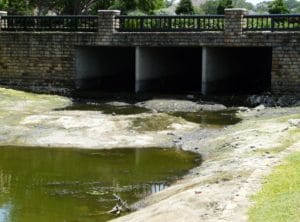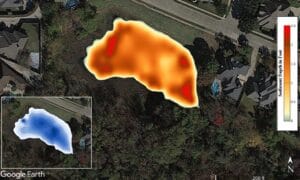How deep is your pond or lake? Dropping anchor in a few places may give you a general idea, but with sediment buildup over the years, it may not be as deep as you thought. In fact, your pond may have an unhealthy or unsafe layer of sediment. A bathymetric and sediment lake survey from Magnolia Fisheries will answer these questions and others.
The estimated lifetime of an urban retention pond in North Texas is approximately 15-20 years. Without renovation, most ponds will continue to get shallower until they become dry land. Organic matter decays and accumulates on the pond bottom over time (leaves, grass, algae, aquatic vegetation, and plankton). Sedimentation rates are elevated in urban areas because soil disturbance from development and poor drainage issues amplify the aging process. Impermeable surfaces such as concrete and rooftops allow storm-water to deposit high levels of soil, sand, and gravel into the nearest pond.

Low water conditions exposing areas of sediment accumulation
Eutrophication is the scientific term that describes a pond’s natural tendency to move toward dry land. Highly eutrophic ponds are often shallow and overloaded with nutrients that fuel noxious algae blooms. During the summer, the sediment layer releases methane and sulfur gases that cause septic odors. Sediment also contains hazardous substances such as heavy metals and pesticides. In fact, the EPA refers to highly eutrophic ponds as “polluted”.
Shallow water created by accumulated sediment creates optimum conditions for noxious aquatic growth and provides breeding ground for mosquitoes. It becomes a health hazard if someone were to fall in or attempt to swim in affected ponds. The sediment layer is essentially a thick, dense “soup”. Should someone enter the pond, they would be unable to swim or walk in areas with over 3 feet of sediment buildup. In fact, drownings are possible in areas with excessive sediment accumulation.
Finally, most urban ponds/lakes are engineered for flood water retention. Excess sediment reduces the intended holding capacity of the pond; which can increase the risk of flooding. See our page on Urban Ponds for more about the effects water depth and accumulated sediment have on maintenance.

Detailed Sediment Contour Map
The most effective way to renovate a pond is through mechanical or hydraulic dredging. The cost of dredging is driven by the amount of material that needs to be removed and disposed of. But how do you know how much material there is? Magnolia Fisheries can answer that question after a survey of the pond’s water depth and sediment layer. We incorporate survey grade data collection technologies and advanced software to generate detailed, accurate, and easy to understand maps. Every survey will come with a report that includes total volume and percent fill of sediment. These surveys are essential for budgeting dredge projects and/or establishing a benchmark for monitoring future sedimentation.
